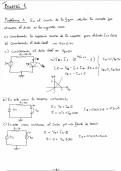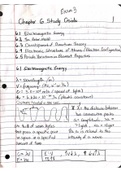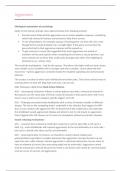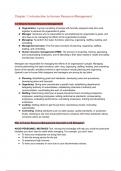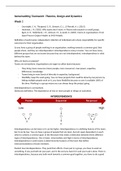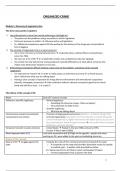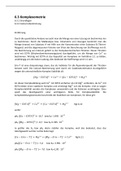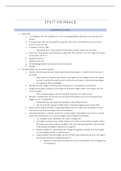Bi p c
Divisions of the nervous system
The human nervous system :
- Body wide system of nerve cells that collects information from the world, processes
this info and then takes action by directing body organs and muscles via the
transmission of electrochemical messages
- The nervous system is broken down into two parts: the central nervous system
(CNS) and the peripheral nervous system (PNS)
The central nervous system: in charge of complex processing
- Comprised of the brain: all conscious and most unconscious processing
- And the spinal cord: receives and transmits info, some reflex processing
The peripheral nervous system: body wide network of messenger neurons
- Sensory neurons to CNS
- Motor neurons away from CNS
- Contains the somatic nervous system (SNS): controls skeletal muscles (movement)
and voluntary system (conscious control)
- Also contains the autonomic nervous system (ANS): controls actions of all internal
organs and gland, is involuntary system (unconscious control)
- the ANS is split into the sympathetic and parasympathetic branches - work
together to regulate internal environment
→ Sympathetic: increases bodily activities, releases noradrenaline and activates
during fight or flight e.g. increased heart rate and inhibits digestion
→ parasympathetic: decreases bodily activities, release of acetylcholine, activates
during rest (rest and digest) e.g. heart rate decreases and stimulates digestion
Homeostasis : regulation of the internal environment, in normal conditions there is a
balance between sympathetic and parasympathetic systems - this is called maintaining
homeostasis
The reflex arc: the structure and function of sensory, relay and motor neurons:
,→ there are three types of neurons, neurons are the basic building blocks of the nervous
system - they are nerve cells that process and transmit messages through electrical and
chemical signals
1. Sensory neurons: carry messages from the PNS to the CNS, these have long
dendrites and short axons
2. Relay neurons: connect the sensory neurons to the motor neurons or other relay
neurons. These have short dendrites and short axons
3. Motor neurons: connect the CNS to effectors such as muscles and glands. They
have short dendrites and long axons
Structure of a neuron:
→ The cell body includes a nucleus, this contains the genetic material of the cell.
Branch-like structures called dendrites protrude from the cell body. These carry nerve
impulses from neighbouring neurons to the cell body
→ the axon carries the impulses away from the cell body down the length of the neuron.
The axon is covered in a fatty layer called the myelin sheath (made up of schwann cells)
that protects the amazon and speeds up the electrical transmission of the impulse.
→ The myelin sheath is segmented by gaps called nodes of Ranvier. These speed up the
transmission of the impulse by forcing it to ‘jump’ across the gaps along the axon
→ finally at the end of the axon are terminal buttons that communicate with the next
neuron in the chain across the synapse
Electric transmission - the firing of a neuron:
, → when a neuron is in a resting state the inside of the cell in negatively charged compared
to the outside
→ when a neuron is activated by a stimulus, the inside of the cell becomes positively
charged for a split second causing an action potential to occur
→ this creates an electrical impulse that travels down the axon towards the end of the
neuron
Synaptic transmission:
→ Synapse: the point where one neuron (presynaptic) can send a chemical message to an
adjacent neuron (postsynaptic)
→ electric impulses cannot cross from the axon terminal to the adjacent dendrite so it must
pass info as as chemical messengers
→ neurotransmitters: chemical messengers released by neurons. Stimulating or inhibiting
the development of an action potential in other postsynaptic neurons
Process of synaptic transmission:
1. An impulse arrives at the end of the presynaptic neuron
2. Vesicles move forwards and fuse with the presynaptic membrane, this releases
neurotransmitters into the presynaptic cleft
3. The neurotransmitters diffuse across the synaptic cleft (down the concentration
gradient)
Divisions of the nervous system
The human nervous system :
- Body wide system of nerve cells that collects information from the world, processes
this info and then takes action by directing body organs and muscles via the
transmission of electrochemical messages
- The nervous system is broken down into two parts: the central nervous system
(CNS) and the peripheral nervous system (PNS)
The central nervous system: in charge of complex processing
- Comprised of the brain: all conscious and most unconscious processing
- And the spinal cord: receives and transmits info, some reflex processing
The peripheral nervous system: body wide network of messenger neurons
- Sensory neurons to CNS
- Motor neurons away from CNS
- Contains the somatic nervous system (SNS): controls skeletal muscles (movement)
and voluntary system (conscious control)
- Also contains the autonomic nervous system (ANS): controls actions of all internal
organs and gland, is involuntary system (unconscious control)
- the ANS is split into the sympathetic and parasympathetic branches - work
together to regulate internal environment
→ Sympathetic: increases bodily activities, releases noradrenaline and activates
during fight or flight e.g. increased heart rate and inhibits digestion
→ parasympathetic: decreases bodily activities, release of acetylcholine, activates
during rest (rest and digest) e.g. heart rate decreases and stimulates digestion
Homeostasis : regulation of the internal environment, in normal conditions there is a
balance between sympathetic and parasympathetic systems - this is called maintaining
homeostasis
The reflex arc: the structure and function of sensory, relay and motor neurons:
,→ there are three types of neurons, neurons are the basic building blocks of the nervous
system - they are nerve cells that process and transmit messages through electrical and
chemical signals
1. Sensory neurons: carry messages from the PNS to the CNS, these have long
dendrites and short axons
2. Relay neurons: connect the sensory neurons to the motor neurons or other relay
neurons. These have short dendrites and short axons
3. Motor neurons: connect the CNS to effectors such as muscles and glands. They
have short dendrites and long axons
Structure of a neuron:
→ The cell body includes a nucleus, this contains the genetic material of the cell.
Branch-like structures called dendrites protrude from the cell body. These carry nerve
impulses from neighbouring neurons to the cell body
→ the axon carries the impulses away from the cell body down the length of the neuron.
The axon is covered in a fatty layer called the myelin sheath (made up of schwann cells)
that protects the amazon and speeds up the electrical transmission of the impulse.
→ The myelin sheath is segmented by gaps called nodes of Ranvier. These speed up the
transmission of the impulse by forcing it to ‘jump’ across the gaps along the axon
→ finally at the end of the axon are terminal buttons that communicate with the next
neuron in the chain across the synapse
Electric transmission - the firing of a neuron:
, → when a neuron is in a resting state the inside of the cell in negatively charged compared
to the outside
→ when a neuron is activated by a stimulus, the inside of the cell becomes positively
charged for a split second causing an action potential to occur
→ this creates an electrical impulse that travels down the axon towards the end of the
neuron
Synaptic transmission:
→ Synapse: the point where one neuron (presynaptic) can send a chemical message to an
adjacent neuron (postsynaptic)
→ electric impulses cannot cross from the axon terminal to the adjacent dendrite so it must
pass info as as chemical messengers
→ neurotransmitters: chemical messengers released by neurons. Stimulating or inhibiting
the development of an action potential in other postsynaptic neurons
Process of synaptic transmission:
1. An impulse arrives at the end of the presynaptic neuron
2. Vesicles move forwards and fuse with the presynaptic membrane, this releases
neurotransmitters into the presynaptic cleft
3. The neurotransmitters diffuse across the synaptic cleft (down the concentration
gradient)

